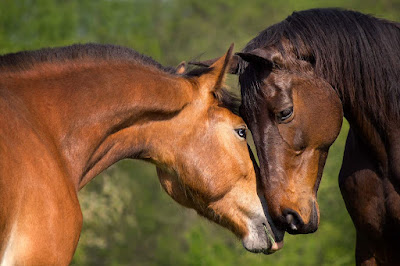Equine infectious anemia EIA virus in horses
Equine infectious anemia, or EIA, is a blood borne viral disease transmitted primarily through insects, particularly horse flies and deer flies. It can infect horses, ponies, donkeys and mules.
 |
| Horse |
Infection is spread primarily through insect bites, but EIAV can also be transmitted through contaminated needles and other instruments, or passed on from mare to foal during pregnancy.
Outbreaks can frequently develop in late summer and early fall in temperate regions, coinciding with peak populations of biting insects.
After EIAV infects a horse there is a 7-45 day incubation period before disease signs are seen.
The virus triggers an immune response, but this is not effective in eliminating the infection. EIAV infected horses carry it for life – there is no cure.
A test for EIA antibodies was established in the 1970s. The Cog-gins test was approved by the United States Department of Agriculture in 1973. It was developed by Leroy Coggins, one of the initial founders of NC State’s College of Veterinary Medicine program.
The test uses a blood sample, and can determine is a horse is infected within two days. Other types of test are also used to confirm a positive result, but the Coggins test is internationally recognized as the gold standard in diagnosing and helping control EIA.There is no vaccination against EIAV.
There are three forms of EIA:
1.Acute
Severe signs of the disease display rapidly, and horses can die within 2-3 weeks. The acute form occurs so quickly that often an elevated body temperature is the only sign seen. These horses can survive and go on to become chronically infected or inapparent carriers.
2.Chronic
If horses survive the acute infection, they can develop disease signs caused by the horse’s immune response to the virus, which include:
Recurrent episodes of a sudden rise in temperature to 105° or more followed by recovery. In mild cases, a fever can last less than a day.
Decreased appetite and chronic weight loss.
Swelling of the lower chest, abdomen and legs (edema).
Decreased number of red blood cells (anemia) and an irregular heartbeat.
Thin or watery blood, blood-stained feces.
Pinpoint-sized hemorrhages on mucous membranes.
Depression, with general listlessness and a head hanged low.
3. Inapparent
The majority of infected horses become in apparent carriers, with no signs of disease unless exposed to a severe stress. While their blood harbors less virus, they continue to represent a risk to other horses, albeit lower than a horse with active clinical signs of disease. These carriers are only likely to be detected when they are tested for EIA.
Control
EIA is much less common today than it was in the 1960’s or 1970’s, but it remains a very dangerous disease. EIAV infection is always reportable, and each state has its own requirements for testing.
The risk of infection is increased:
In the vicinity of outbreaks.
When new horses without negative Coggins tests enter the pasture or stable.
When exposed at horse events when negative Coggins tests are not required.
When pasturing horses in swampy areas, or when horses are not regularly tested.
The only protection is prevention.
